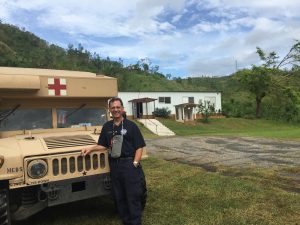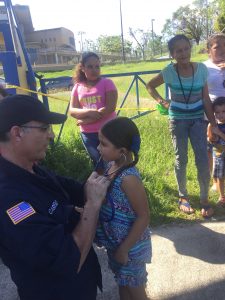How to Help Provide Emergency Disaster Services
PA Expert Caruso Recommends Preparation and Training
August 28, 2022
By Eileen Denne, CAE
Most PAs don’t hesitate to use their skills and training to help others in need. Have you wondered how to help people before, during, and after natural disasters? Here are some things you need to know.

“During any disaster,” says Frank Caruso, PA-C, “the folks involved in the event will come together regardless of economic status, race, creed, or political persuasion and help each other – everybody is on a level playing field. I think this is a major motivator for most people who choose to reach out and get involved in providing any level of emergency service during a disaster. The challenge for PAs who have never done this type of work is to understand that they will be asked to possibly work out of their comfort zone. PAs have to get basic training if they want to be effective during a disaster, so they can be part of the solution, and not the problem.
“There’s a big learning curve. You cannot just want to get involved in providing disaster services when a disaster occurs! A PA needs to go through the educational process to learn basic skills, join an organization that provides this service, set the time aside to practice with that organization, and develop adequate knowledge and skills to go into an area and serve effectively and safely.”
PA Caruso is a PA in orthopaedic surgery in Winston Salem, North Carolina, affiliated with Wake Forest Baptist Medical Center. He leads AAPA’s special interest group, the Disaster Medicine Association of PAs, and is a strong advocate for PAs to join a local, state, or national group that organizes disaster teams. He started by joining the volunteer fire department many years ago and is still an active firefighter and paramedic.
Start disaster training in your community
An easy way to get more involved, he says, is to join a Federal Emergency Management Agency (FEMA)-sponsored Community Emergency Response Team (CERT), which educates volunteers about disaster preparedness. There are 2,700 CERT programs nationwide, with 600,000 trained individuals. The CERT Basic Course is taught by a team of first responders and other volunteers. During the sessions, participants are required to bring safety equipment and disaster supplies to build a disaster response kit of items they’ll need during a disaster.
The American Red Cross sponsors Disaster Action Teams whose members serve as the first, on-the-scene Red Cross contacts at the site of disasters to conduct damage assessments or do initial casework. They do not authorize PAs to serve as medical providers during disasters. All Red Cross volunteers participate in free online and in-person training in their local offices.
One of the best training options for a PA, Caruso says, is to get on a State Medical Assistance Team (SMAT). “Google SMAT in your state,” Caruso says, “and see if they have any medical openings. The training is generally excellent and coordinated with other emergency medical services in that state and you will get called to help out in disasters that involve your state or neighboring states.” On a state level there are also non-governmental agencies that provide similar services and can be an excellent choice as well.

Join a DMAT for more involvement
A greater level of involvement entails joining a Disaster Medical Assistance Team (DMAT). DMATs are part of the National Disaster Medical System (NDMS), which include trauma, medical, critical care teams, and a national mortuary and veterinary response team. On each team, there are about 60 people, including PAs, nurse practitioners, physicians, registered nurses, paramedics, pharmacists, and logistical, safety, and communications specialists. Each DMAT is on quarterly rotation, meaning a particular team will likely be deployed if a disaster occurs on the month they are scheduled to be first out. Deployments can last up to 30 days. In the DMAT model, all members become intermittent federal employees and have the same protection as full-time federal employees. Just as in other disaster services, DMAT members are required to participate in hands-on training and have mandatory online training year-round. Deployed DMAT members are protected under the Uniformed Services Employment and Reemployment Rights Act, meaning that employers have to grant a leave of absence for deployment, using vacation, annual leave, or similar leave.
Caruso, who is deputy commander of North Carolina DMAT Team NC-1, was deployed last fall to Puerto Rico when Hurricane Maria hit and served as deputy commander of the DMAT. During the month that Hurricane Maria hit, his teams had already been deployed to Texas and Florida so federal resources were really taxed.
“Once we arrived in Puerto Rico, we were staged in San Juan with 500 other medical providers. After missions were handed out we were sent throughout the island to support fixed-site facilities such as hospitals, shelters, and floating medical ships (USS Comfort); we set up new facilities (mobile medical tent units) or provided direct service at shelters, schools, churches, or door-to-door in communities that had little to no medical services. My group had a number of missions that were more focused in the middle of Puerto Rico. One of our missions included being flown into inaccessible areas by Chinook Helicopter. It was a rather unique experience for all of us. In total the North Carolina DMAT was in Puerto Rico for 17 days; some of our team members went back for additional assignments.”
Medical care during disasters require flexibility
Caruso says that during disasters such as the 2017 hurricanes, “PAs have to care for patients under a different paradigm. We are trying to do the most for patients with limited resources. The key is to do the greatest good for the greatest number of patients with limited resources, not to give the most care for each patient as we learn in PA school. It can be a challenge when providers are in these disasters and don’t always have what they need to treat patients – especially with limited medical and pharmaceutical caches. We may not be able to treat medical conditions or provide surgical support the way we normally would, or we may have to choose not to treat patients whose death is imminent.
“A lot of disaster events also involve hurry up and wait mentality which can be a challenge for healthcare professionals used to providing medical services right away,” Caruso adds.
Caruso recommends all PAs learn about disaster medicine by reading the latest news on the CDC and the NDMS websites monthly and by attending free trainings. “There’s basic knowledge that all PAs need to have. Then, in times of need, we can get involved.”
Many states have Good Samaritan laws that offer legal protection to people who assist a person who is injured or in danger. The laws protect the “Good Samaritan” from liability if unintended consequences result from their assistance.
The AAPA special interest group, Disaster Medicine Association of PAs, is looking for volunteers to help collect resources for a PA clearinghouse on disaster medicine. If interested in joining the group and/or helping with creating more resources, contact Caruso at [email protected].
Editor’s note: This article originally appeared in August 2018.
More Resources
After Disasters PAs Provide Critical Medical Care
Boston Marathon Bombing: The PA Perspective Video
Eileen Denne is director of Corporate Communications at AAPA. Contact her at [email protected].
Thank you for reading AAPA’s News Central
You have 2 articles left this month. Create a free account to read more stories, or become a member for more access to exclusive benefits! Already have an account? Log in.



